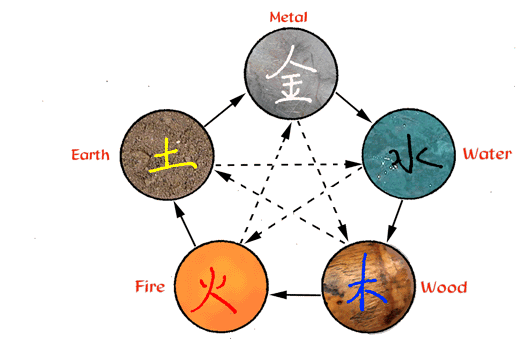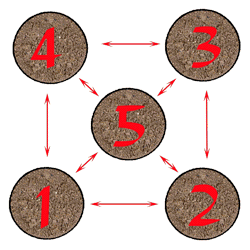
Shaolin Hung Mei Theory
THEORY OF "WŬ HÁNG"
"Wŭ Háng" (五行) is an involved series of techniques which teach the disciple shifting, blocking, counter attacking and methods for forcing an opponent to lose control of his or her center of gravity resulting in a loss of balance. The student learns how to pinpoint and strike at vulnerable areas on an opponent's torso regardless of the method of initial attack. There are two underlying theories that govern the philosophy and movement behind "Wŭ Háng" (五行): 1) the Theory of the Five Elements, and 2) the Theory of Five Steps.
Theory of the Five Elements
The philosophy of the Five Elements is common to many styles of Kung Fu (功夫). In Hung Méi (洪眉), we will use it to help understand the concept behind Wŭ Háng (五行).

As can be seen, the five elements are commonly found in nature. The elements that are aligned around the outside of the circle are mutually constructive. The metal helps the water when heavy ores sink to the bottom of a moving stream and keep it clear and flowing smoothly. Water is a key element in allowing trees to grow large and strong. Wood is the fuel for the fire. The ashes resulting from the fire burning the wood supply nutrients for the ground. Lastly, the ground is where the metal is formed.
Within the circle, the elements are mutually destructive. Steel or metal can easily destroy wood. As trees grow, they pull nutrients out of the ground. Loose dirt and soil muddy a stream. Water puts out the fire and the fire will melt the metal.
But in what way does this concept of the Five Elements relate to Wŭ Háng (五行)? In performing Wŭ Háng (五行), the practitioner will frequently use one hand to block an attack and the other to counter the opponent. The student must always remember that although at one moment of time, the blocking hand is helping, at another, the opponent can grab that hand, twist it and use it as a means of harming the student. As it is in nature, an element can be both constructive and destructive at the same time.
Theory of the Five Steps
The theory of five steps teaches the student proper shifting and foot placement when faced with an attack. The figure below illustrates the positions of the Five Steps.

To practice the steps, the student will assume what is called “Horse Stance” (Zuò Mă - 坐馬) and follow the same basic procedure as with the exercise "Tai Zŭ Shù Quán" (太祖術拳), with one major exception. In Tai Zŭ Shù Quán (太祖術拳), all of the pivoting motion occurs around the right foot. In the practice of the five steps of Wŭ Háng (五行), the pivot foot alternates between the right and the left. In other words, in the first sequence, the left foot is in position #1 and the right in position #2. After pivoting around the right foot, the left will end up at #3 while the right remains in #2. However, in the third sequence, the pivot occurs around the left foot. It will remain in #3 while the right foot moves to #4. The exercise would continue with the student alternating the support leg.
The second part of following the five steps uses the center location, #5. The student stands in “Front Stance” (Qián Mă - 前馬) with one foot in any of the four corner locations and the other in the center. He or she is facing an imaginary opponent who is in the same stance facing the opposite way. As the opponent shifts his outside foot from corner to corner, the student must move in the same circular direction in order to maintain proper alignment. If the opponent pulls his lead foot out of the center, places it in a corner and then placing the other foot in the center position, the student must do the same.
Proper foot placement, distancing and positioning are critical to the effective execution of Wŭ Háng (五行), or for that matter, any technique.
